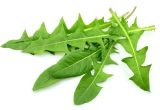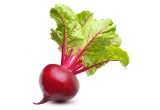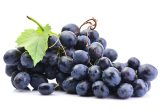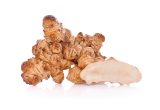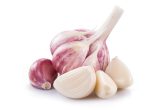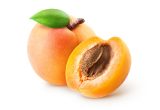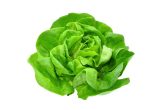Leek

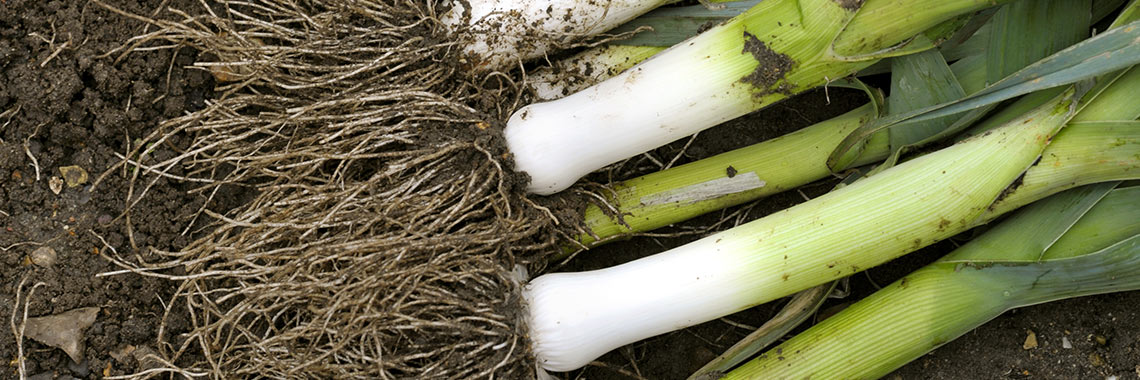
Description
- The leek (Allium porrum) is a vegetable that belongs to the Alliaceae family.
PHYSICAL AND ORGANOLEPTIC CHARACTERISTICS
- The leek is in the form of a large cylinder, white at the base, composed of long overlapping leaves that are dark green at the tip (Bernaert, 2013).
- The main compounds responsible for the taste of leek are methiine and isoaliine (Bernaert, 2013). An analysis was carried out on 31 leek cultivars to quantify these 2 compounds. It was found that the white part of leek contains a higher amount of isollin (15 to 53 mg/g) and methiin (3 to 16 mg/g) than the green part (9 to 45 mg/g of isollin and 1 to 10 mg/g of methiin) (Bernaert, 2012).
- The presence of sulphur compounds, specifically S-alkyl-cysteine sulphoxides, also participates in the taste of leek. These are transformed into volatile sulphur compounds (e.g. thiosulphinates) during cooking (Ravindran, 2017). Bitterness is contributed by the presence of saponins (Ravindran, 2017).
COMPOSITION CHARACTERISTICS (excluding macronutrients, vitamins and minerals)
- Leeks contain kaempferol derivatives and quercetin derivatives, the concentrations of which differ from cultivar to cultivar (Soininen, 2014).
- Phenolic compounds are present in greater amounts in the green part of the leaves, compared to the white part. The resulting antioxidant property is logically more important in the green part than in the white part (Strati, 2018).
- The white part of the leek also contains twelve organic acids, some of which have also been shown to have antioxidant activity, such as boric acid, fumaric acid, stearic acid and oleic acid (Benedé, 2019).
- Preliminary studies on cells have suggested that leek extract exhibits anti-allergenic (Benedé, 2019) and anti-cancer properties (Zamri, 2019), particularly due to the antioxidant and anti-inflammatory capabilities provided by the phenolic compounds it contains.
- In addition, the amino acids valine and proline contained in leeks have immuno-stimulatory properties that may participate in the beneficial effects previously mentioned (Bénédé, 2019).
RAW
The following values are approximate and depend on variety, season, ripeness, cultivation conditions, etc.
Raw leek is low in energy*. On average, it provides 32.30 calories (kcal) per 100 g, i.e. 136 kJ.
One leek weighs on average 150 g, which represents an energy intake of 48.45 kcal when raw.
COMPOSITION TABLES
For each nutrient, the tables provide information on the content, the minimum and maximum values, as well as the percentage of the Dietary Reference Values (DRVs) for 100 g of raw leek.
*Regulation (EC) No 1924/2006 of the European Parliament and of the Council of 20 December 2006 on nutrition and health claims made on foods.
MACRONUTRIENTS
| Constituent (g) | Average content |
Min-Max per 100g |
DRV% |
|---|---|---|---|
| Water | 87,6 | 83 - 93,20 | - |
| Fibers | 2,27 | 1,80 - 2,80 | - |
| Carbohydrates | 4,90 | 4,30 - 5,50 | 1,88 |
| Sugars | 3,15 | 2,40 - 3,90 | 3,50 |
| Lipids | 0,25 | 0,10 - 0,50 | 0,36 |
| Saturated fat | 0,05 | 0,04 - 0,089 | 0,25 |
| Protein | 1,49 | 1,10 - 3,13 | 2,98 |
| Constituent (g) | Amount | Min-Max | DRV% |
|---|---|---|---|
| Water | Ciqual 2020 | - | - |
| Fibers | Ciqual 2020 | - | - |
| Carbohydrates | Ciqual 2020 | - | Règlement (UE) N°1169/2011 du parlement Européen, et du conseil du 25 octobre 2011 |
| Sugars | Ciqual 2020 | - | Règlement (UE) N°1169/2011 du parlement Européen, et du conseil du 25 octobre 2011 |
| Lipids | Ciqual 2020 | - | Règlement (UE) N°1169/2011 du parlement Européen, et du conseil du 25 octobre 2011 |
| Saturated fat | Ciqual 2020 | - | Règlement (UE) N°1169/2011 du parlement Européen, et du conseil du 25 octobre 2011 |
| Protein | Ciqual 2020 | - | Règlement (UE) N°1169/2011 du parlement Européen, et du conseil du 25 octobre 2011 |
Zoom on carbohydrates
- The carbohydrate content of raw leeks (4.90 g per 100 g) is slightly higher than the average amount of carbohydrate found in raw vegetables (4.45 g per 100 g).
- Raw leeks are low in sugar* as they contain less than 5 g per 100 g.
Zoom on fibres
- Raw leeks provide a significant amount of fibre: 2.27 g per 100 g.
- This amount is slightly lower than the average quantity of fibre in raw vegetables (2.43 g per 100 g).
Zoom on proteins
- Their protein content (1.49 g per 100 g) is slightly lower than the average for this macronutrient in raw vegetables (1.87 g per 100 g).
Zoom on lipids
- Their fat content (0.25 g per 100 g) is lower than the average amount of fat found in raw vegetables (0.56 g per 100 g).
- Leeks are fat-free* as they contain less than 0.5 g per 100 g.
*Regulation (EC) No 1924/2006 of the European Parliament and of the Council of 20 December 2006 on nutrition and health claims made on foods.
MINERALS AND TRACE ELEMENTS
| Constituent | Average content |
Min-Max per 100g |
DRV% |
|---|---|---|---|
| Calcium (mg) | 50,70 | 18 - 155 | 6,34 |
| Chloride (mg) | - | - | - |
| Copper (mg) | 0,087 | 0,021 - 0,16 | 8,70 |
| Iron (mg) | 1,50 | 0,39 - 2,70 | 10,71 |
| Iodine (µg) | 1,10 | 0,40 - 2 | 0,73 |
| Magnesium (mg) | 19 | 7,60 - 28 | 5,07 |
| Manganese (mg) | 0,34 | 0,12 - 0,48 | 17 |
| Phosphorus (mg) | 40,30 | 23,60 - 61,30 | 5,76 |
| Potassium (mg) | 208 | 180 - 347 | 10,40 |
| Selenium (µg) | 0,56 | NC - 1,80 | 1,02 |
| Sodium (mg) | 14,50 | 5 - 20 | - |
| Zinc (mg) | 0,21 | 0,11 - 0,73 | 2,10 |
| Constituent | Amount | Min-Max | DRV% |
|---|---|---|---|
| Calcium (mg) | Ciqual 2020 | - | Règlement (UE) N°1169/2011 du parlement Européen, et du conseil du 25 octobre 2011 |
| Chloride (mg) | - | - | Règlement (UE) N°1169/2011 du parlement Européen, et du conseil du 25 octobre 2011 |
| Copper (mg) | Ciqual 2020 | - | Règlement (UE) N°1169/2011 du parlement Européen, et du conseil du 25 octobre 2011 |
| Iron (mg) | Ciqual 2020 | - | Règlement (UE) N°1169/2011 du parlement Européen, et du conseil du 25 octobre 2011 |
| Iodine (µg) | Ciqual 2020 | - | Règlement (UE) N°1169/2011 du parlement Européen, et du conseil du 25 octobre 2011 |
| Magnesium (mg) | Ciqual 2020 | - | Règlement (UE) N°1169/2011 du parlement Européen, et du conseil du 25 octobre 2011 |
| Manganese (mg) | Ciqual 2020 | - | Règlement (UE) N°1169/2011 du parlement Européen, et du conseil du 25 octobre 2011 |
| Phosphorus (mg) | Ciqual 2020 | - | Règlement (UE) N°1169/2011 du parlement Européen, et du conseil du 25 octobre 2011 |
| Potassium (mg) | Ciqual 2020 | - | Règlement (UE) N°1169/2011 du parlement Européen, et du conseil du 25 octobre 2011 |
| Selenium (µg) | Ciqual 2020 | - | Règlement (UE) N°1169/2011 du parlement Européen, et du conseil du 25 octobre 2011 |
| Sodium (mg) | Ciqual 2020 | - | - |
| Zinc (mg) | Ciqual 2020 | - | Règlement (UE) N°1169/2011 du parlement Européen, et du conseil du 25 octobre 2011 |
Zoom on minerals and trace elements
- Raw leeks are a source of manganese because they provide the equivalent of 17% of DRVs, i.e. 0.34 mg per 100 g.
- They also contain significant amounts of iron and potassium. They provide the equivalent of:
- 10.71% of DRVs for iron, i.e. 1.50 mg per 100 g;
- 10.40% of DRVs for potassium, i.e. 208 mg per 100 g.
- Raw leek provides the equivalent of:
- 8.70% of DRVs for copper, i.e. 0.087 mg per 100 g;
- 6.34% of DRVs for calcium, i.e. 50.70 mg per 100 g.
- The other minerals and trace elements are present in smaller quantities in raw leeks, since they cover less than 6% of DRVs.
VITAMINS
| Constituent | Average content |
Min-Max per 100g |
DRV% |
|---|---|---|---|
| Provitamin A Beta-carotene (µg) | 1 000 | - | - |
| Vitamin A equivalent (µg) | 166,67 | - | 20,83 |
| Vitamin B1 (mg) | 0,065 | 0,032 - 0,15 | 5,91 |
| Vitamin B2 (mg) | 0,065 | 0,03 - 0,18 | 4,64 |
| Vitamin B3 (mg) | 0,50 | 0,29 - 0,85 | 3,13 |
| Vitamin B5 (mg) | 0,13 | 0,12 - 0,14 | 2,17 |
| Vitamin B6 (mg) | 0,24 | 0,15 - 0,60 | 17,14 |
| Vitamin B9 (µg) | 73 | 64 - 82 | 36,50 |
| Vitamin C (mg) | 18,50 | 11 - 74 | 23,13 |
| Vitamin E (mg) | 0,74 | 0,30 - 1,30 | 6,17 |
| Vitamin K1 (µg) | 47 | - | 62,67 |
| Constituent | Amount | Min-Max | DRV% |
|---|---|---|---|
| Provitamin A Beta-carotene (µg) | Ciqual 2020 | - | - |
| Vitamin A equivalent (µg) | Calcul à partir de la valeur Provitamine A Béta-carotène* | - | Règlement (UE) N°1169/2011 du parlement Européen, et du conseil du 25 octobre 2011 |
| Vitamin B1 (mg) | Ciqual 2020 | - | Règlement (UE) N°1169/2011 du parlement Européen, et du conseil du 25 octobre 2011 |
| Vitamin B2 (mg) | Ciqual 2020 | - | Règlement (UE) N°1169/2011 du parlement Européen, et du conseil du 25 octobre 2011 |
| Vitamin B3 (mg) | Ciqual 2020 | - | Règlement (UE) N°1169/2011 du parlement Européen, et du conseil du 25 octobre 2011 |
| Vitamin B5 (mg) | Ciqual 2020 | - | Règlement (UE) N°1169/2011 du parlement Européen, et du conseil du 25 octobre 2011 |
| Vitamin B6 (mg) | Ciqual 2020 | - | Règlement (UE) N°1169/2011 du parlement Européen, et du conseil du 25 octobre 2011 |
| Vitamin B9 (µg) | Ciqual 2020 | - | Règlement (UE) N°1169/2011 du parlement Européen, et du conseil du 25 octobre 2011 |
| Vitamin C (mg) | Ciqual 2020 | - | Règlement (UE) N°1169/2011 du parlement Européen, et du conseil du 25 octobre 2011 |
| Vitamin E (mg) | Ciqual 2020 | - | Règlement (UE) N°1169/2011 du parlement Européen, et du conseil du 25 octobre 2011 |
| Vitamin K1 (µg) | Ciqual 2020 | - | Règlement (UE) N°1169/2011 du parlement Européen, et du conseil du 25 octobre 2011 |
Zoom on vitamins
- Raw leeks are high in:
- vitamin K1 because they provide the equivalent of 62.67% of DRVs, i.e. 47 µg per 100 g
- vitamin B9 because they provide the equivalent of 36.50% of DRVs, i.e. 73 µg per 100 g.
- They are also a source of:
- vitamin C because they provide the equivalent of 23.13% of DRVs, i.e. 18.50 mg per 100 g;
- vitamin A because they provide the equivalent of 20.83% of DRVs, i.e. 166.67 µg per 100 g;
- vitamin B6 because they provide the equivalent of 17.14% of DRVs, i.e. 0.24 mg per 100 g.
- The other vitamins are present in smaller quantities, since they cover less than 7% of DRVs.
*Calculation made: Beta Carotene / 6 + retinol
POLYPHENOLS
BOILED
The following values are approximate and depend on variety, season, ripeness, cultivation conditions, etc.
Leeks boiled in water are low in energy*. On average, they provide 27.40 calories (kcal) per 100 g, i.e. 114 kJ.
One leek weighs on average 150 g, which represents an energy intake of 41.10 kcal when boiled in water.
COMPOSITION TABLES
For each nutrient, the tables provide information on the content, the minimum and maximum values, as well as the percentage of the Dietary Reference Values (DRVs) for 100 g net of leek boiled in water.
*Regulation (EC) No 1924/2006 of the European Parliament and of the Council of 20 December 2006 on nutrition and health claims made on foods.
MACRONUTRIENTS
| Constituent (g) | Average content |
Min-Max per 100g |
DRV% |
|---|---|---|---|
| Water | 91,6 | - | - |
| Fibers | 3,40 | - | - |
| Carbohydrates | 2,23 | 0 - NC | 0,86 |
| Sugars | 1,80 | - | 2 |
| Lipids | < 0,30 | - | - |
| Saturated fat | < 0,01 | - | - |
| Protein | 2,56 | 2,50 - NC | 5,12 |
| Constituent (g) | Amount | Min-Max | DRV% |
|---|---|---|---|
| Water | Ciqual 2020 (valeur issue de l'analyse Ciqual-Aprifel 2018) | - | - |
| Fibers | Ciqual 2020 (valeur issue de l'analyse Ciqual-Aprifel 2018) | - | - |
| Carbohydrates | Ciqual 2020 | - | Règlement (UE) N°1169/2011 du parlement Européen, et du conseil du 25 octobre 2011 |
| Sugars | Ciqual 2020 (valeur issue de l'analyse Ciqual-Aprifel 2018) | - | Règlement (UE) N°1169/2011 du parlement Européen, et du conseil du 25 octobre 2011 |
| Lipids | Ciqual 2020 (valeur issue de l'analyse Ciqual-Aprifel 2018) | - | Règlement (UE) N°1169/2011 du parlement Européen, et du conseil du 25 octobre 2011 |
| Saturated fat | Ciqual 2020 (valeur issue de l'analyse Ciqual-Aprifel 2018) | - | Règlement (UE) N°1169/2011 du parlement Européen, et du conseil du 25 octobre 2011 |
| Protein | Ciqual 2020 | - | Règlement (UE) N°1169/2011 du parlement Européen, et du conseil du 25 octobre 2011 |
Zoom on carbohydrates
- The carbohydrate content of boiled leek (2.23 g per 100 g) is lower than the average amount of carbohydrates found in cooked vegetables (4.85 g per 100 g).
- These are mainly fructose (0.80 g per 100 g), glucose (0.70 g per 100 g) and sucrose (0.30 g per 100 g).
- Boiled leeks are low in sugar* as they contain less than 5 g per 100 g.
Zoom on fibres
- Leeks boiled in water are a source of fibre* as they provide more than 3 g of fibre per 100 g, i.e. 3.40 g per 100 g.
- This amount is higher than the average fibre quantity in cooked vegetables (2.89 g per 100 g).
Zoom on proteins
- Boiled leeks provide a higher amount of protein (2.56 g per 100 g) than the average for this macronutrient in cooked vegetables (2 g per 100 g).
Zoom on lipids
- Boiled leeks are fat-free* as they contain less than 0.5 g of fat per 100 g
*Regulation (EC) No 1924/2006 of the European Parliament and of the Council of 20 December 2006 on nutrition and health claims made on foods.
MINERALS AND TRACE ELEMENTS
| Constituent | Average content |
Min-Max per 100g |
DRV% |
|---|---|---|---|
| Calcium (mg) | 35 | - | 4,38 |
| Chloride (mg) | 33 | - | 4,13 |
| Copper (mg) | 0,08 | - | 8 |
| Iron (mg) | 0,45 | - | 3,21 |
| Iodine (µg) | < 20 | - | - |
| Magnesium (mg) | 6,50 | - | 1,73 |
| Manganese (mg) | 0,11 | - | 5,50 |
| Phosphorus (mg) | 26 | - | 3,71 |
| Potassium (mg) | 120 | - | 6 |
| Selenium (µg) | < 20 | - | - |
| Sodium (mg) | < 5 | - | - |
| Zinc (mg) | 0,14 | - | 1,40 |
| Constituent | Amount | Min-Max | DRV% |
|---|---|---|---|
| Calcium (mg) | Ciqual 2020 (valeur issue de l'analyse Ciqual-Aprifel 2018) | - | Règlement (UE) N°1169/2011 du parlement Européen, et du conseil du 25 octobre 2011 |
| Chloride (mg) | Ciqual 2020 (valeur issue de l'analyse Ciqual-Aprifel 2018) | - | Règlement (UE) N°1169/2011 du parlement Européen, et du conseil du 25 octobre 2011 |
| Copper (mg) | Ciqual 2020 (valeur issue de l'analyse Ciqual-Aprifel 2018) | - | Règlement (UE) N°1169/2011 du parlement Européen, et du conseil du 25 octobre 2011 |
| Iron (mg) | Ciqual 2020 (valeur issue de l'analyse Ciqual-Aprifel 2018) | - | Règlement (UE) N°1169/2011 du parlement Européen, et du conseil du 25 octobre 2011 |
| Iodine (µg) | Ciqual 2020 (valeur issue de l'analyse Ciqual-Aprifel 2018) | - | Règlement (UE) N°1169/2011 du parlement Européen, et du conseil du 25 octobre 2011 |
| Magnesium (mg) | Ciqual 2020 (valeur issue de l'analyse Ciqual-Aprifel 2018) | - | Règlement (UE) N°1169/2011 du parlement Européen, et du conseil du 25 octobre 2011 |
| Manganese (mg) | Ciqual 2020 (valeur issue de l'analyse Ciqual-Aprifel 2018) | - | Règlement (UE) N°1169/2011 du parlement Européen, et du conseil du 25 octobre 2011 |
| Phosphorus (mg) | Ciqual 2020 (valeur issue de l'analyse Ciqual-Aprifel 2018) | - | Règlement (UE) N°1169/2011 du parlement Européen, et du conseil du 25 octobre 2011 |
| Potassium (mg) | Ciqual 2020 (valeur issue de l'analyse Ciqual-Aprifel 2018) | - | Règlement (UE) N°1169/2011 du parlement Européen, et du conseil du 25 octobre 2011 |
| Selenium (µg) | Ciqual 2020 (valeur issue de l'analyse Ciqual-Aprifel 2018) | - | Règlement (UE) N°1169/2011 du parlement Européen, et du conseil du 25 octobre 2011 |
| Sodium (mg) | Ciqual 2020 (valeur issue de l'analyse Ciqual-Aprifel 2018) | - | - |
| Zinc (mg) | Ciqual 2020 (valeur issue de l'analyse Ciqual-Aprifel 2018) | - | Règlement (UE) N°1169/2011 du parlement Européen, et du conseil du 25 octobre 2011 |
Zoom on minerals and trace elements
- Boiled leek provides the equivalent of:
- 8% of DRVs for copper, i.e. 0.08 mg per 100 g;
- 6% of DRVs for potassium, i.e. 120 mg per 100 g;
- 5.50% of DRVs for manganese, i.e. 0.11 mg per 100 g.
- The amount of other minerals and trace elements represents less than 5% of DRVs.
VITAMINS
| Constituent | Average content |
Min-Max per 100g |
DRV% |
|---|---|---|---|
| Provitamin A Beta-carotene (µg) | 343 | - | - |
| Vitamin A equivalent (µg) | 57,17 | - | 7,15 |
| Vitamin B1 (mg) | 0,028 | - | 2,55 |
| Vitamin B2 (mg) | < 0,01 | - | - |
| Vitamin B3 (mg) | 0,30 | - | 1,88 |
| Vitamin B5 (mg) | 0,088 | - | 1,47 |
| Vitamin B6 (mg) | 0,055 | - | 3,93 |
| Vitamin B9 (µg) | 22,80 | - | 11,40 |
| Vitamin C (mg) | 3,79 | - | 4,74 |
| Vitamin E (mg) | 0,75 | - | 6,25 |
| Vitamin K1 (µg) | 3,60 | - | 4,80 |
| Constituent | Amount | Min-Max | DRV% |
|---|---|---|---|
| Provitamin A Beta-carotene (µg) | Ciqual 2020 (valeur issue de l'analyse Ciqual-Aprifel 2018) | - | - |
| Vitamin A equivalent (µg) | Calcul à partir de la valeur Provitamine A Béta-carotène* | - | Règlement (UE) N°1169/2011 du parlement Européen, et du conseil du 25 octobre 2011 |
| Vitamin B1 (mg) | Ciqual 2020 (valeur issue de l'analyse Ciqual-Aprifel 2018) | - | Règlement (UE) N°1169/2011 du parlement Européen, et du conseil du 25 octobre 2011 |
| Vitamin B2 (mg) | Ciqual 2020 (valeur issue de l'analyse Ciqual-Aprifel 2018) | - | Règlement (UE) N°1169/2011 du parlement Européen, et du conseil du 25 octobre 2011 |
| Vitamin B3 (mg) | Ciqual 2020 (valeur issue de l'analyse Ciqual-Aprifel 2018) | - | Règlement (UE) N°1169/2011 du parlement Européen, et du conseil du 25 octobre 2011 |
| Vitamin B5 (mg) | Ciqual 202 (valeur issue de l'analyse Ciqual-Aprifel 2018) | - | Règlement (UE) N°1169/2011 du parlement Européen, et du conseil du 25 octobre 2011 |
| Vitamin B6 (mg) | Ciqual 2020 (valeur issue de l'analyse Ciqual-Aprifel 2018) | - | Règlement (UE) N°1169/2011 du parlement Européen, et du conseil du 25 octobre 2011 |
| Vitamin B9 (µg) | Ciqual 2020 (valeur issue de l'analyse Ciqual-Aprifel 2018) | - | Règlement (UE) N°1169/2011 du parlement Européen, et du conseil du 25 octobre 2011 |
| Vitamin C (mg) | Ciqual 2020 (valeur issue de l'analyse Ciqual-Aprifel 2018) | - | Règlement (UE) N°1169/2011 du parlement Européen, et du conseil du 25 octobre 2011 |
| Vitamin E (mg) | Ciqual 2020 (valeur issue de l'analyse Ciqual-Aprifel 2018) | - | Règlement (UE) N°1169/2011 du parlement Européen, et du conseil du 25 octobre 2011 |
| Vitamin K1 (µg) | Ciqual 2020 (valeur issue de l'analyse Ciqual-Aprifel 2018) | - | Règlement (UE) N°1169/2011 du parlement Européen, et du conseil du 25 octobre 2011 |
Zoom on vitamins
- Boiled leeks contain a significant amount of vitamin B9. They provide the equivalent of 11.40% of DRVs, i.e. 22.80 µg per 100 g.
- They also provide the equivalent of:
- 7.15% of DRVs for vitamin A, i.e. 57.17 µg per 100 g;
- 6.25% of DRVs for vitamin E, i.e. 0.75 mg per 100 g.
- The other vitamins are present in smaller quantities, since they represent less than 5% of DRVs.
*Calculation made: Beta Carotene / 6 + retinol
POLYPHENOLS
Constituent
(mg)
Average content
Min-Max
per 100mg
Total polyphenols
0,32
0,32 - 0,32
Constituent
(mg)
Amount
Min-Max
Total polyphenols
Phénol-Explorer version 3.6 Méthode utilisée : Dosage du folin
-
Zoom on polyphenols
- Polyphenols are substances with an antioxidant effect.
- According to the folin method, leeks boiled in water contain 0.32 mg of polyphenols per 100 g.
Nutrition and health claims
According to the definitions of nutrition claims as set out in Regulation (EC) No 1924/2006 on nutrition and health claims, and in view of the composition of raw leek, the following claims may be used:
NUTRITION CLAIMS OF RAW LEEK
- Fat-free (100 g of raw leek contain less than 0.5 g of fat)
- Low in sugar (100 g of raw leek contain less than 5 g of sugar)
- Low in energy (100 g of raw leek provide less than 40 kcal)
- High in vitamin K1 (100 g of raw leek provide more than 30% of DRVs)
- High in vitamin B9 (100 g of raw leek provide more than 30% of DRVs)
- Source of vitamin C (100 g of raw leek provide more than 15% of DRVs)
- Source of vitamin A (100 g of raw leek provide more than 15% of DRVs)
- Source of vitamin B6 (100 g of raw leek provide more than 15% of DRVs)
- Source of manganese (100 g of raw leek provide more than 15% of DRVs)
HEALTH CLAIMS (for a consumption of 100 g of raw leek)
Vitamin K1
- Vitamin K1 contributes to:
- maintenance of normal bones,
- normal blood clotting.
Folates or vitamin B9
- Folates contribute to:
- maternal tissue growth during pregnancy,
- normal amino acid synthesis,
- normal blood formation,
- normal homocysteine metabolism,
- normal psychological function,
- normal function of the immune system,
- reduction of tiredness and fatigue.
- Folates have a role in the process of cell division.
Vitamin C
- Vitamin C contributes to:
- normal function of the immune system during and after intense physical exercise,
- normal collagen formation for the normal function of blood vessels,
- normal collagen formation for the normal function of bones,
- normal collagen formation for the normal function of cartilage,
- normal collagen formation for the normal function of gums,
- normal collagen formation for the normal function of skin,
- normal collagen formation for the normal function of teeth,
- normal energy-yielding metabolism,
- normal functioning of the nervous system,
- normal psychological function,
- normal function of the immune system,
- protection of cells from oxidative stress,
- reduction of tiredness and fatigue,
- regeneration of the reduced form of vitamin E.
- Vitamin C increases iron absorption.
Vitamin A
- Vitamin A has a role in the process of cell specialisation.
- Vitamin A contributes to:
- maintenance of normal skin,
- maintenance of normal mucous membranes,
- maintenance of normal vision,
- normal iron metabolism ,
- normal function of the immune system.
Vitamin B6
- Vitamin B6 contributes to:
- normal cysteine synthesis,
- normal homocysteine metabolism,
- normal energy-yielding metabolism,
- normal functioning of the nervous system,
- normal protein and glycogen metabolism,
- normal psychological function,
- normal red blood cell formation,
- normal function of the immune system,
- reduction of tiredness and fatigue,
- regulation of hormonal activity.
Manganese
- Manganese contributes to:
- normal energy-yielding metabolism,
- maintenance of normal bones,
- normal formation of connective tissues,
- protection of cells from oxidative stress.
Nutrition and health claims
According to the definitions of nutrition claims as set out in Regulation (EC) No 1924/2006 on nutrition and health claims, and in view of the composition of cooked leek, the following claims may be used:
NUTRITION CLAIMS OF BOILED LEEK
- Fat-free (100 g of boiled leek contain less than 0.5 g of fat)
- Low in sugar (100 g of boiled leek contain less than 5 g of sugar)
- Low in energy (100 g of boiled leek provide less than 40 kcal)
- Source of fibre (100 g of boiled leek provide more than 3 g of fibre)
References
- Benedé S, Gradillas A, Villalba M, Batanero E. Allium porrum Extract Decreases Effector Cell Degranulation and Modulates Airway Epithelial Cell Function. Nutrients. 2019;11(6).
- Bernaert N, Wouters D, De Vuyst L, De Paepe D, De Clercq H, Van Bockstaele E, De Loose M, Van Droogenbroeck B. Antioxidant changes of leek (Allium ampeloprasum var. porrum) during spontaneous fermentation of the white shaft and green leaves. J Sci Food Agric. 2013;93(9):2146-53.
- Bernaert N, Goetghebeur L, De Clercq H, De Loose M, Daeseleire E, Van Pamel E, Van Bockstaele E, Van Droogenbroeck B. Influence of cultivar and harvest time on the amounts of isoalliin and methiin in leek (Allium ampeloprasum var. porrum). J Agric Food Chem. 2012;60(44):10910-9.
- Neveu V, Perez-Jiménez J, Vos F, Crespy V, du Chaffaut L, Mennen L, Knox C, Eisner R, Cruz J, Wishart D, Scalbert A. (2010) Phenol-Explorer: an online comprehensive database on polyphenol contents in foods. Database, doi: 10.1093/database/bap024. Full text (free access)
- P N Ravindran (2017) The Encyclopedia of Herbs and Spices. CABI, 1176 p.
- Règlement (CE) N° 1924/2006 du Parlement européen et du Conseil du 20 décembre 2006 concernant les allégations nutritionnelles et de santé portant sur les denrées alimentaires.
- Règlement (UE) N°432/2012 de la Commission du 16 mai 2012 établissant une liste des allégations de santé autorisées portant sur les denrées alimentaires, autres que celles faisant référence à la réduction du risque de maladie ainsi qu’au développement et à la santé infantiles.
- Règlement (UE) n°1169/2011 du Parlement européen et du Conseil du 25 octobre 2011 concernant l’information des consommateurs sur les denrées alimentaires, modifiant les règlements (CE) n°1924/2006 et (CE) n°1925/2006 du Parlement européen et de Conseil et abrogeant la directive 87/250/CEE de la Commission, la directive 90/496/CEE du Conseil, la directive 1999/10/CE de la Commission, la directive 200/13/CE du Parlement européen et du Conseil, les directives 2002/67/CE et 2008/5/CE de la Commission et le règlement (CE) n°608/2004 de la Commission.
- Soininen TH, Jukarainen N, Soininen P, Auriola SO, Julkunen-Tiitto R, Oleszek W, Stochmal A, Karjalainen RO, Vepsäläinen JJ. Metabolite profiling of Leek (Allium porrum L) cultivars by (1) H NMR and HPLC-MS. Phytochem Anal. 2014;25(3):220-8.
- Strati IF, Kostomitsopoulos G, Lytras F, Zoumpoulakis P, Proestos C, Sinanoglou VJ. Optimization of Polyphenol Extraction from Allium ampeloprasum var. porrum through Response Surface Methodology. Foods. 2018;7(10)
- Table de composition nutritionnelle des aliments CIQUAL (2020) – via le site internet www.anses.fr, consultée le …
- Zamri N, Hamid HA. Comparative Study of Onion (Allium cepa) and Leek (Allium ampeloprasum): Identification of Organosulphur Compounds by UPLC-QTOF/MS and Anticancer Effect on MCF-7 Cells. Plant Foods Hum Nutr. 2019;74(4):525-30.






